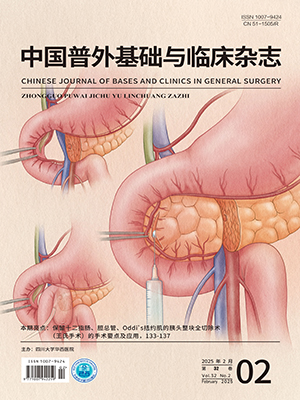| 1. |
World Health Organization (WHO). Global battle against cancer won’t be won with treatment alone-effective prevention measures urgently needed to prevent cancer crisis. Cent Eur J Public Health, 2014, 22(1): 23, 28.
|
| 2. |
McGlynn KA, London WT. The global epidemiology of hepatocellular carcinoma: present and future. Clin Liver Dis, 2011, 15(2): 223-243.
|
| 3. |
Llovet JM, Bruix J. Novel advancements in the management of hepatocellular carcinoma in 2008. J Hepatol, 2008, 48 Suppl 1: S20-S37.
|
| 4. |
Yuen MF, Cheng CC, Lauder IJ, et al. Early detection of hepatocellular carcinoma increases the chance of treatment: Hong Kong experience. Hepatology, 2000, 31(2): 330-335.
|
| 5. |
Chalasani N, Said A, Ness R, et al. Screening for hepatocellular carcinoma in patients with cirrhosis in the United States: results of a national survey. Am J Gastroenterol, 1999, 94(8): 2224-2229.
|
| 6. |
Vogl TJ, Kümmel S, Hammerstingl R, et al. Liver tumors: comparison of MR imaging with Gd-EOB-DTPA and Gd-DTPA. Radiology, 1996, 200(1): 59-67.
|
| 7. |
Choi JW, Lee JM, Kim SJ, et al. Hepatocellular carcinoma: imaging patterns on gadoxetic acid-enhanced MR images and their value as an imaging biomarker. Radiology, 2013, 267(3): 776-786.
|
| 8. |
Kitao A, Matsui O, Yoneda N, et al. Hypervascular hepatocellular carcinoma: correlation between biologic features and signal intensity on gadoxetic acid-enhanced MR images. Radiology, 2012, 265(3): 780-789.
|
| 9. |
Yamashita T, Kitao A, Matsui O, et al. Gd-EOB-DTPA-enhanced magnetic resonance imaging and alpha-fetoprotein predict prognosis of early-stage hepatocellular carcinoma. Hepatology, 2014, 60(5): 1674-1685.
|
| 10. |
Shin SK, Kim YS, Shim YS, et al. Peritumoral decreased uptake area of gadoxetic acid enhanced magnetic resonance imaging and tumor recurrence after surgical resection in hepatocellular carcinoma: A STROBE-compliant article. Medicine (Baltimore), 2017, 96(33): e7761.
|
| 11. |
Asayama Y, Tajima T, Nishie A, et al. Uptake of Gd-EOB-DTPA by hepatocellular carcinoma: radiologic-pathologic correlation with special reference to bile production. Eur J Radiol, 2011, 80(3): e243-e248.
|
| 12. |
Korean Society of Abdominal Radiology. Diagnosis of hepatocellular carcinoma with gadoxetic acid-enhanced MRI: 2016 Consensus Recommendations of the Korean Society of Abdominal Radiology. Korean J Radiol, 2017, 18(3): 427-443.
|
| 13. |
Kim SH, Kim SH, Lee J, et al. Gadoxetic acid-enhanced MRI versus triple-phase MDCT for the preoperative detection of hepatocellular carcinoma. AJR Am J Roentgenol, 2009, 192(6): 1675-1681.
|
| 14. |
Hwang J, Kim SH, Lee MW, et al. Small (≤2 cm) hepatocellular carcinoma in patients with chronic liver disease: comparison of gadoxetic acid-enhanced 3.0 T MRI and multiphasic 64-multirow detector CT. Br J Radiol, 2012, 85(1015): e314-e322.
|
| 15. |
Kim HD, Lim YS, Han S, et al. Evaluation of early-stage hepatocellular carcinoma by magnetic resonance imaging with gadoxetic acid detects additional lesions and increases overall survival. Gastroenterology, 2015, 148(7): 1371-1382.
|
| 16. |
Yoo SH, Choi JY, Jang JW, et al. Gd-EOB-DTPA-enhanced MRI is better than MDCT in decision making of curative treatment for hepatocellular carcinoma. Ann Surg Oncol, 2013, 20(9): 2893-2900.
|
| 17. |
Choi JY, Kim MJ, Park YN, et al. Gadoxetate disodium-enhanced hepatobiliary phase MRI of hepatocellular carcinoma: correlation with histological characteristics. AJR Am J Roentgenol, 2011, 197(2): 399-405.
|
| 18. |
Fujita N, Nishie A, Kubo Y, et al. Hepatocellular carcinoma: clinical significance of signal heterogeneity in the hepatobiliary phase of gadoxetic acid-enhanced MR imaging. Eur Radiol, 2015, 25(1): 211-220.
|
| 19. |
Kiryu S, Akai H, Nojima M, et al. Impact of hepatocellular carcinoma heterogeneity on computed tomography as a prognostic indicator. Sci Rep, 2017, 7(1): 12689.
|
| 20. |
de Lope CR, Tremosini S, Forner A, et al. Management of HCC. J Hepatol, 2012, 56 Suppl 1: S75-S87.
|
| 21. |
Ruà S, Comino A, Fruttero A, et al. Flow cytometric DNA analysis of cirrhotic liver cells in patients with hepatocellular carcinoma can provide a new prognostic factor. Cancer, 1996, 78(6): 1195-1202.
|
| 22. |
Duseja A. Staging of hepatocellular carcinoma. J Clin Exp Hepatol, 2014, 4(Suppl 3): S74-S79.
|
| 23. |
Huppertz A, Haraida S, Kraus A, et al. Enhancement of focal liver lesions at gadoxetic acid-enhanced MR imaging: correlation with histopathologic findings and spiral CT—initial observations. Radiology, 2005, 234(2): 468-478.
|
| 24. |
刘曦娇, 唐鹤菡, 张笑, 等. 钆塞酸二钠增强 MRI 肝胆期信号与肝细胞肝癌分化程度的关系. 中国普外基础与临床杂志, 2014, 21(12): 1583-1586.
|
| 25. |
Nanashima A, Abo T, Tobinaga S, et al. Relationship between period of survival and clinicopathological characteristics in patients with hepatocellular carcinoma who underwent hepatectomy. Hepatogastroenterology, 2010, 57(99-100): 540-546.
|
| 26. |
Miyaaki H, Nakashima O, Kurogi M, et al. Lens culinaris agglutinin-reactive alpha-fetoprotein and protein induced by vitamin K absence II are potential indicators of a poor prognosis: a histopathological study of surgically resected hepatocellular carcinoma. J Gastroenterol, 2007, 42(12): 962-968.
|




